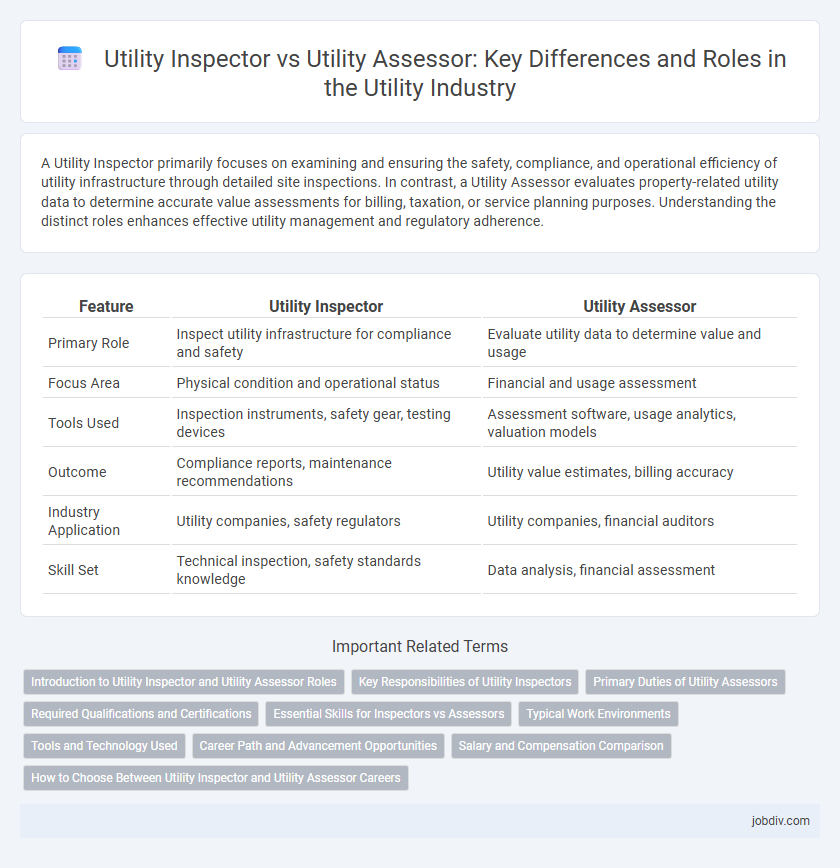A Utility Inspector primarily focuses on examining and ensuring the safety, compliance, and operational efficiency of utility infrastructure through detailed site inspections. In contrast, a Utility Assessor evaluates property-related utility data to determine accurate value assessments for billing, taxation, or service planning purposes. Understanding the distinct roles enhances effective utility management and regulatory adherence.
Table of Comparison
| Feature | Utility Inspector | Utility Assessor |
|---|---|---|
| Primary Role | Inspect utility infrastructure for compliance and safety | Evaluate utility data to determine value and usage |
| Focus Area | Physical condition and operational status | Financial and usage assessment |
| Tools Used | Inspection instruments, safety gear, testing devices | Assessment software, usage analytics, valuation models |
| Outcome | Compliance reports, maintenance recommendations | Utility value estimates, billing accuracy |
| Industry Application | Utility companies, safety regulators | Utility companies, financial auditors |
| Skill Set | Technical inspection, safety standards knowledge | Data analysis, financial assessment |
Introduction to Utility Inspector and Utility Assessor Roles
Utility Inspectors primarily focus on evaluating the condition and safety of utility infrastructure, conducting inspections of pipelines, electrical lines, and water systems to ensure compliance with regulatory standards. Utility Assessors analyze the value and performance of utility services, performing assessments related to billing accuracy, service quality, and property valuation for utility taxation purposes. Both roles are essential in maintaining efficient, safe, and fair utility operations through distinct but complementary responsibilities.
Key Responsibilities of Utility Inspectors
Utility Inspectors primarily ensure compliance with safety regulations and operational standards by conducting thorough inspections of utility installations such as electrical lines, gas pipelines, and water systems. They identify potential hazards, verify maintenance schedules, and document any discrepancies to prevent service disruptions and accidents. Their role includes enforcing regulatory protocols and coordinating with utility companies to implement corrective actions promptly.
Primary Duties of Utility Assessors
Utility Assessors primarily evaluate property values for taxation purposes by inspecting land, buildings, and utility infrastructure to ensure accurate tax assessments. They analyze utility-related assets such as pipelines, power lines, and water systems, determining depreciation and market value to support fair property tax calculations. Their role involves maintaining detailed records and collaborating with utility companies and local governments to verify data and resolve valuation discrepancies.
Required Qualifications and Certifications
Utility Inspectors typically require a high school diploma or equivalent and specialized training in utility systems, along with certifications such as OSHA safety certification and confined space entry. Utility Assessors often need a higher level of education, such as an associate or bachelor's degree in engineering or environmental science, plus certifications like Certified Energy Manager (CEM) or Professional Engineer (PE) license. Both roles demand familiarity with regulatory standards, but assessors usually require advanced analytical skills supported by technical certifications.
Essential Skills for Inspectors vs Assessors
Utility Inspectors must possess strong analytical skills, attention to detail, and thorough knowledge of safety regulations to identify potential hazards and ensure compliance during infrastructure inspections. Utility Assessors require proficiency in data evaluation, risk assessment, and report writing to accurately appraise asset conditions and forecast maintenance needs. Both roles demand excellent communication abilities, but Inspectors emphasize onsite problem-solving while Assessors focus on strategic planning and decision-making based on collected data.
Typical Work Environments
Utility Inspectors typically work on-site at power plants, water treatment facilities, or underground utility networks, conducting inspections to ensure compliance with safety regulations and operational standards. Utility Assessors often operate in office environments or field settings, analyzing utility data, preparing reports, and evaluating property values related to utility infrastructure. Both roles require frequent travel to various locations, but Inspectors spend more time in physically demanding environments while Assessors focus on data-driven assessments.
Tools and Technology Used
Utility Inspectors utilize advanced diagnostic tools such as pipeline cameras, leak detectors, and GIS mapping software to identify faults in utility infrastructure effectively. Utility Assessors rely heavily on data analysis software, geographic information systems (GIS), and remote sensing technologies to evaluate property utility value and service efficiency accurately. Both roles increasingly integrate mobile applications and cloud-based platforms to enhance data collection and reporting accuracy in dynamic operational environments.
Career Path and Advancement Opportunities
Utility Inspectors typically begin their careers overseeing the safety and compliance of utility installations, gaining hands-on field experience essential for advancement. Utility Assessors, on the other hand, often progress by developing expertise in property valuation and regulatory standards, positioning themselves for roles in auditing or senior evaluation. Both career paths offer opportunities for specialization and promotion within municipal agencies or private utility companies, with advancing roles often requiring certifications and continued education.
Salary and Compensation Comparison
Utility Inspectors typically earn an average salary ranging from $50,000 to $75,000 annually, reflecting their role in overseeing utility infrastructure compliance and safety. Utility Assessors often receive compensation between $45,000 and $70,000 per year, depending on experience and regional demand, as they focus on evaluating utility property values for taxation or billing purposes. Salary variations are influenced by geographic location, industry sector, and level of expertise within utility regulation and assessment fields.
How to Choose Between Utility Inspector and Utility Assessor Careers
Utility Inspectors ensure compliance with safety regulations by conducting on-site inspections of electrical, gas, and water utilities, focusing on risk identification and maintenance standards. Utility Assessors evaluate utility properties' value for taxation or sale, requiring strong analytical skills in asset valuation and market assessment. Choosing between these careers depends on your preference for fieldwork and regulatory enforcement (Utility Inspector) versus data analysis and financial evaluation (Utility Assessor).
Utility Inspector vs Utility Assessor Infographic

 jobdiv.com
jobdiv.com